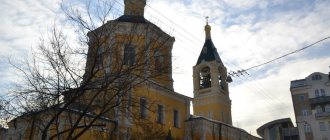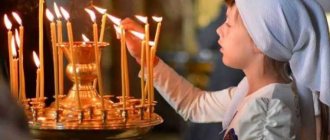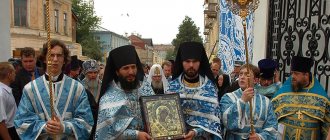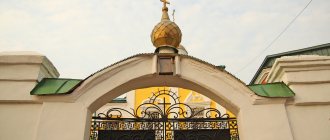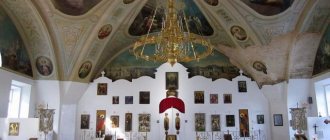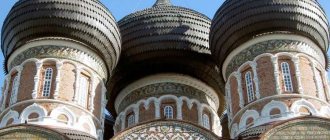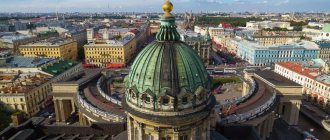A little history
The Kazan Cathedral first appeared in Moscow back in 1620. At that time the building was entirely wooden. It was erected in honor of Russia's victory in the war of 1612. D. Pozharsky allocated money for the construction of the temple. Unfortunately, this cathedral was not destined to stand for long. Most of it was destroyed by fire. It was possible to rebuild the temple only in the 1630s. The new building became the destination for participants in the religious procession, which was organized after the discovery of icons, victories in battles with enemies, etc.
This was the case until 1765. Later, the cathedral was reconstructed and repaired many times, changing its appearance and interior decoration. One of the largest restorations took place in 1925. Its ideological author was Pyotr Baranovsky. The famous architect set himself the goal of reviving the temple in the form in which it was originally created.
The man failed to implement the grandiose project. He made corresponding attempts for several years, after which the Kazan Cathedral was simply demolished (this decision was made by the capital city council). On the site of an important architectural monument, a pavilion dedicated to the Third International was built.
Kazan Temple
The site is unofficial archive of the parish history of the Kazan Church for 2004-2020; photographs, videos, Sunday leaflets and other materials for this period are stored here.The Kazan Church in the village of Glebovo is an architectural monument of the 19th century. Built in 1859 with the blessing of St. Philaret, Metropolitan of Moscow and Kolomna, at the expense of the landowner Major and Cavalier Stepan Stepanovich Shilovsky, who was buried in the church along with his mother and wife.
The most beautiful temple was built according to the design of the outstanding architect K.A. Ton, who was also the creator of the Cathedral of Christ the Savior, the Grand Kremlin Palace and the Armory Chamber. The prototype of the Kazan Church in Glebovo was the Church of the Annunciation of the Blessed Virgin Mary of the Life Guards Cavalry Regiment, created by K.A. Ton in 1844-1849. This temple was located in the very center of St. Petersburg (modern Labor Square), in 1929 it suffered the same fate as the Cathedral of Christ the Savior - it was blown up and completely destroyed. The prototype of the Horse Guards Church, like the Kazan one, was distinguished by a special, ancient Russian tent-shaped form, which, moreover, was repeated in the architecture of the temple four more times, in the side domes, which were used as bell towers. S.S. Shilovsky spared no effort and money to decorate the house of God. Bells and striking clocks were placed in two side towers, “looking” to the southwest. In the temple there was a wonderful Kazan icon, in Greek writing, a bronze gilded chandelier weighing 15 pounds and a tabernacle - silver, gilded, weighing 37 pounds, which was a model of the temple itself. According to a contemporary, “everything in the church, down to the smallest detail, breathes some kind of peculiarity and grace.” M.P. Mussorgsky, who visited the Shilovskys in the summer of 1859, wrote about his impressions: to the composer Balakirev: “Dear Mily, ... a luxurious manor house, on the mountain; The English garden (a type of park) is wonderful, ... everything is magnificent, the church is small, a kind of cathedral.”
After the revolution, the rector of the church, priest Alexy Smirnov, and his family, which included six children, were deprived of their civil rights as a minister of the Church. The priest's family was in dire straits. In October 1928, the church council of the temple turned to believers with a request “to help our priest with a necessary item, bread, in view of the refusal to issue him rations, with the most necessary things for existence and life. Citizens, we ask you to help our priest with rye grain or flour, as much as you can.” For twenty years the Smirnovs were dispossessed and existed thanks to their fellow villagers who helped in every way they could.
In 1938, Father Alexy was subject to another “cultural and income tax” in the amount of 5,805 rubles. Moreover, the tax amount had to be paid in February 1938. Since the priest had no money, he again turned to the believers to help pay the tax.
In 1938, Father Alexy was arrested and executed at the training ground in Butovo. Hieromartyr Alexy (Smirnov), who carried out pastoral ministry for forty years, was rehabilitated in 1989, and in 2002 he was canonized and included in the Council of New Martyrs and Confessors of Russia. Memory sschmch. Alexia takes place on February 28th.
Having lost its priest, the Kazan Church was desecrated and destroyed. Having survived the occupation, in peacetime the church stood in desolation, gradually collapsing. In 1989-90 The Glebov poultry farm began work on the reconstruction of the temple, however, in subsequent years this work was not carried out. The restoration was resumed in 2004. On November 4, 2003, the newly appointed rector of the temple, priest Alexander Cheprasov, served the first prayer service on the patronal feast of the temple, and on July 21, 2004, on the day of the discovery of the Kazan Icon, the first Divine Liturgy took place.
At a distance of 700 m from the temple, in a picturesque larch grove, there is a holy spring. In 2007, with the blessing of Metropolitan Juvenaly, a chapel-bath in honor of the Kazan Icon of the Mother of God was erected above the source.
At the beginning of 2007, 9 bells were installed on the temple belfry weighing from 6 to 700 kg, and in February 2008 a large “Blagovest” bell was installed weighing 1200 kg.
In 2007, for the first time in the Moscow region, in the center of the village of Glebovsky, with the participation of the local administration, a monument to the holy martyr Alexy Smirnov was erected in honor of the 140th anniversary of his birth and 5 years of canonization as holy new martyrs and confessors of Russia.
From 2008-2014 The parish of the Kazan Church, together with the Moscow Bell Center, organized annual bell ringing festivals.
In 2012, the chiming clock was restored on the temple tower.
In 2013, a canopy was installed on the territory of the temple over the mosaic icon of St. Nicholas the Wonderworker.
In 2021, an outdoor icon case with mosaic icons was installed near the well on the territory of the temple.
There is a children's Sunday school at the church. Pilgrimage trips are regularly organized. A Sunday leaflet is published weekly. The parish provides care for a social rehabilitation center for children in the village of Glebovo-Izbishche.
In accordance with the missionary card, the parish provides care for the Secondary School in the village of Glebovsky, as well as preschool educational institutions: kindergarten No. 46, and kindergarten No. 20 “Rosinka”.
On March 19, 2021, Metropolitan Juvenaly of Krutitsky and Kolomna, concelebrating with Bishop Roman of Serpukhov, performed the great consecration of the temple.
Features of the architectural style and design of the cathedral
The Kazan Cathedral is small, but it should not be underestimated. It looks very festive, primarily due to the abundance of decor. The pillarless, cubic-shaped temple is topped with a pyramid, which consists of 4 kokoshniks. Large ones are located at the bottom, small ones at the top. The latter serve as support for a massive head, fixed with a light drum.
The decor for the first floor is false arches supported by small pylons. They hide a covered gallery, which is used by believers who are not directly inside the cathedral. The parishioners see and hear everything that happens in the church thanks to compact windows.
Looking at the façade of the architectural monument, one cannot help but notice the unique mosaic icons. On the right side is the image of the Kazan Mother of God, on the left is the face of St. George the Victorious. The apse is decorated with the icon “Hermogenes, Patriarch of Moscow”.
The bell tower adjacent to the temple is impressive with its height (at the level of the dome). On major holidays, it gathers crowds of believers, everyone who wants to rejoice in the Lord to the ringing of the Kazan bells.
INTERESTING: Jesus Christ.
The interior of the cathedral cannot be called original, since precise information about what it looked like has not been preserved to this day. The interior decoration of the temple was designed based on descriptions found in old documents created by masters of painting (invited to work on the Kazan Cathedral from Palekh and Bryansk). Today, the inner surface of the church walls is decorated with beautiful frescoes and ornaments.
The history of the famous Kazan Icon of the Mother of God
The icon of the Kazan Mother of God is revered more than others in Orthodoxy. Not only the original image, but also its copies have a miraculous effect. There are many copies of the shrine distributed throughout the world, and all of them are held in special esteem by Christians.
The appearance of the Kazan Icon of the Mother of God is associated with an interesting story that occurred in the 16th century, which can be called a miracle. In 1579, a terrible fire occurred in Kazan, which destroyed all the wooden buildings of the city. That same night, the Mother of God appeared in a dream to the ten-year-old daughter of a local merchant, Matrona. She asked the girl to go to the ashes and find her icon there. At the same time, the Mother of God indicated the exact place where the image is located. In the morning, Matrona told her parents about the vision. They consulted with priest Ermolai and decided to check the veracity of the children's words. And, in fact, under the burnt brands, the icon of the Mother of God seemed to be waiting to be found. The image was wrapped in cherry cloth and was completely untouched by fire. The image of the Virgin Mary on the cypress board looked like new.
Christians noticed the miraculous power of the icon already in the first days. Blind people who fell before the image began to see, and deaf people began to hear. Migraine patients were relieved of terrible pain.
After the healings that occurred, the city’s clergy decided to make several lists. The first was sent to Tsar Ivan the Terrible. The remaining lists were donated to churches located in different cities of Rus'. The icon was kept in parishes and was revered more than other images. Many cathedrals and monasteries were built in her honor.
History of the Moscow Cathedral
The first Kazan Church in Moscow was intended to store the miraculous icon. Funds for its construction were donated by Prince Dmitry Pozharsky. The miraculous power of the icon helped to liberate captured Moscow and defeat the Polish-Lithuanian invaders. Before the construction of the cathedral, the shrine was located in the church on Lubyanka. The icon was moved to a wooden parish near Red Square in 1625. After 9 years, the temple was completely destroyed by fire, but the image was saved.
Construction of the temple
The foundation of a new stone church took place in 1636. The money was allocated from the state treasury by order of Tsar Mikhail Fedorovich. The tented bell tower was added to the north-west side of the main building. The consecration of the temple was carried out in the presence of the sovereign by the main patriarch of Moscow, Joseph I, which is why the church immediately received a high status.
Eleven years later, the Kazan Cathedral was expanded by adding a side chapel. Its consecration in 1647 took place in the presence of Tsar Alexei Mikhailovich. The chapel was consecrated in memory of the wonderworkers of Kazan Guria and Varsanuphia.
In the XVIII-XIX centuries. The cathedral building underwent repeated reconstruction. Princess M.A. Dolgorukova made donations to the needs of the church in the late 1760s. With this money, the building was repaired, the dilapidated chapel of Guria and Barsanuphius was dismantled. Shops for city trade were built along the perimeter of the building. Candles, apples and baked goods were sold there.
Activities in the 19th century
At the beginning of the 19th century. it came to the bell tower. In 1802, the old building was dismantled. Three years later, a new bell tower with two tiers was erected in another place.
During the war with Napoleon, difficult times came for the Kazan Cathedral. Before the arrival of the French, Archpriest Moshkov managed to take out and hide the icon of the Kazan Mother of God. When enemy troops captured the capital, all the temples were desecrated and looted. The Cathedral of the Kazan Icon of the Mother of God was no exception. The French threw the throne out of the building and put a dead horse in its place.
The temple underwent another alteration sixty years later. A third tier appeared on the bell tower. The façade of the cathedral was decorated in the classical style of churches of that time. The clergy of the temple were dissatisfied with the new appearance, believing that the building began to look like an ordinary rural church.
Revolution and Soviet times
After the revolution, life in the Kazan Cathedral changed. Divine services continued for some time, then they were banned. In the fall of 1980, the main shrine, the icon of the Mother of God, was stolen from the temple.
In 1920, an initiator was found who decided to return the façade to its original appearance. This was the famous restorer P. D. Baranovsky. In 1929, the walls of the cathedral were transformed, and the keel-shaped kokoshniks were restored. The reconstruction of the building was not destined to be completed, as the Soviet authorities decided to demolish it. The cathedral interfered with the holding of special events on Red Square. Baranovsky urgently made the necessary measurements of the building and recorded them on paper. Subsequently, these drawings helped to recreate an exact copy of the temple.
In the early 30s. The Kazan Cathedral was closed and a canteen was set up there. After some time, the building was given to the Metropolitan. Marble began to be stored in the church building for finishing the subway. In 1936, a global redevelopment of Manezhnaya Square took place, and the temple was completely demolished. A pavilion was built on this site, and then a summer cafe with a fountain was opened, followed by the construction of a public toilet.
Restoration of the temple
The Kazan Cathedral of the Icon of the Mother of God became the first architectural monument of the city of Moscow, completely destroyed, and then restored according to the surviving drawings. The revival of the temple began in 1990 and lasted three years. The project of the building and management of the work was undertaken by P. D. Baranovsky’s student O. I. Zhurin. He completely restored the appearance of the building using old documents, drawings and photographs. The interior painting of the temple was done in the style of the 19th century, since there were no surviving photographs of the interior decoration. In November 1993, the grand opening and consecration of the Kazan Cathedral took place.
Current state
Currently, the Kazan Cathedral has been completely restored and has its original appearance. The temple is open to tourists, parishioners and pilgrims every day. On weekends and church holidays, liturgies and services are held in the cathedral.
What icons are in the Kazan Cathedral
The main shrine of the Cathedral is the icon of the Virgin Mary of Kazan. Its acquisition dates back to 1579. During the fire, part of the Kazan Kremlin turned into ruins. One of the Streltsy, whose home was very badly damaged, began to carry out active work to restore the house. At the time of this work, the man found the holy face of the Mother of God.
The best article for you, go to: Old Fair Cathedral in Nizhny Novgorod
According to a well-known legend, the Mother of God appeared three times before the little daughter of a Sagittarius. In a dream, the Virgin Mary asked her to find her holy face. At first no one believed the girl, but after visiting the indicated place, the icon was found. Not much time passed when rumors spread about the miracles that this icon performed.
In addition to the icon of Our Lady of Kazan, there are other shrines in the temple. Such, for example, as the image of Panteleimon, Nicholas the Wonderworker and many others.
The icon of the Mother of God in the Kazan Cathedral is open daily for veneration and prayer requests by Orthodox believers. Divine services are also held in the temple.
Current state[edit]
Almshouse
With the blessing of His Grace Veniamin, Bishop of Ardatov and Atyashevsky, in the transferred to the Bishop's courtyard in the village. Makolovo building of a former school, an almshouse is being organized. Single elderly nuns already live there, under the full care of the farmstead.
The nuns take care of the economic needs of the almshouse.
It is necessary to carry out major repairs and reconstruction of the building to create proper living conditions for the inmates of the almshouse. Currently, heating has been installed, a refectory and prosphora have been equipped, some of the cells for nuns have been built, water supply and sewerage have been installed. At this time, work is underway on the construction of cells for nuns and pilgrims, and the reconstruction of the basement for the plumbing block.
Temple bell tower
The bell tower with open arched openings and a tent is built in the best traditions of architecture. When visiting, you should pay attention to the bells. The heaviest of them weighs five tons and is known for the loudest ringing.
History of construction
The bells were cast in the Yaroslavl region:
- festive (358 pounds);
- Sunday (172 pounds);
- everyday (40 pounds);
- six small ones.
The main bell was made in the city of Tutaev at the Shuvalovsky plant. Bells are cast there using ancient technologies.
Exterior design
The impressive bell tower is crowned with identically shaped octagonal drums in the form of pavilions under domes. Restoration work on them and the upper part in general was completed in 1996. That's when the domes turned bright blue.
Listen to the mesmerizing church bells.
Schedule of services
As noted above, the Cathedral is active. It holds daily services according to the following schedule:
- on weekdays the Liturgy begins to be read at 8:00 am;
- on weekends and holidays, Liturgies are read at 8:00 and 17:00.
You can get to the Cathedral by taking the metro. You need to get off at the Ploshchad Revolutsii or Okhotny Ryad metro stations.
God bless you!

